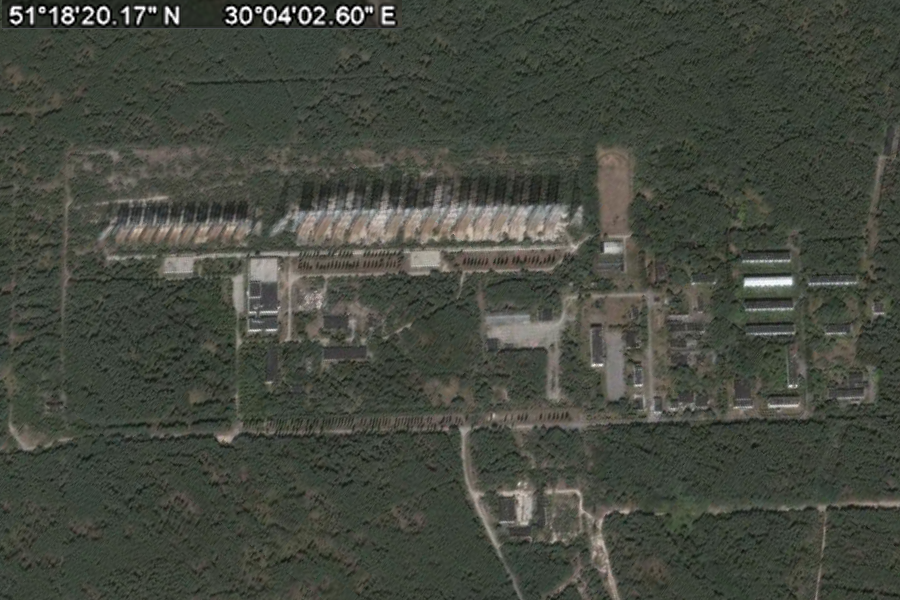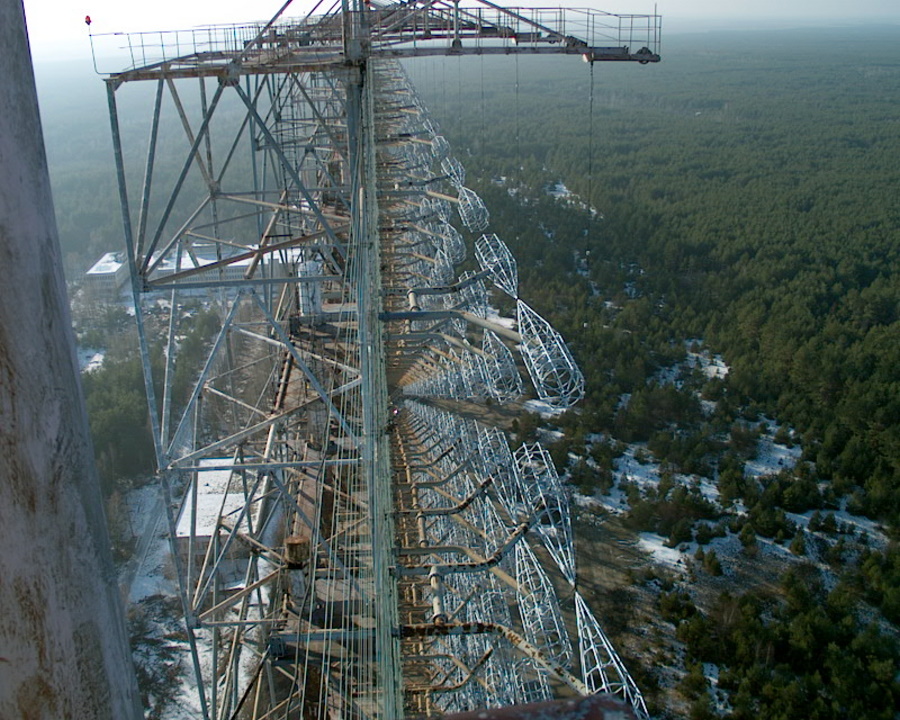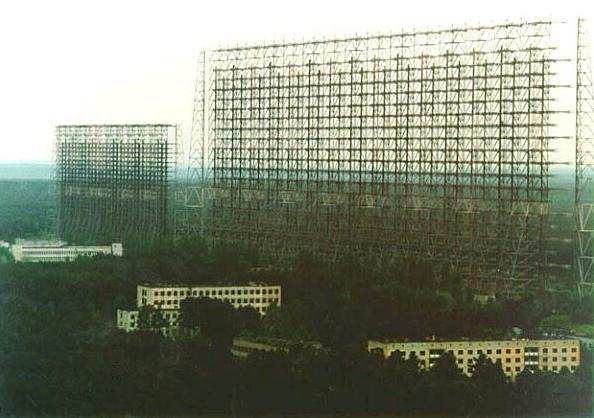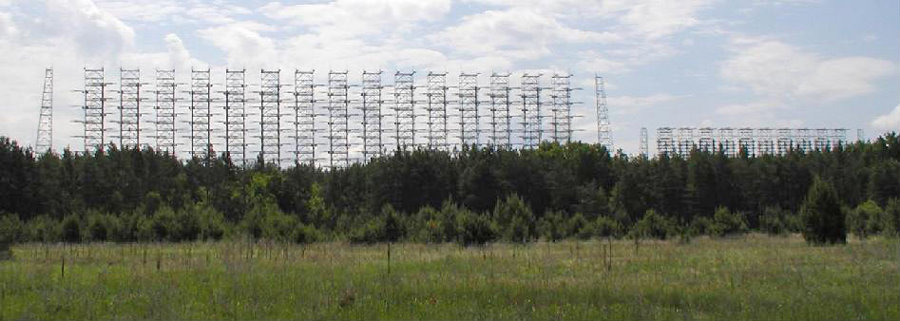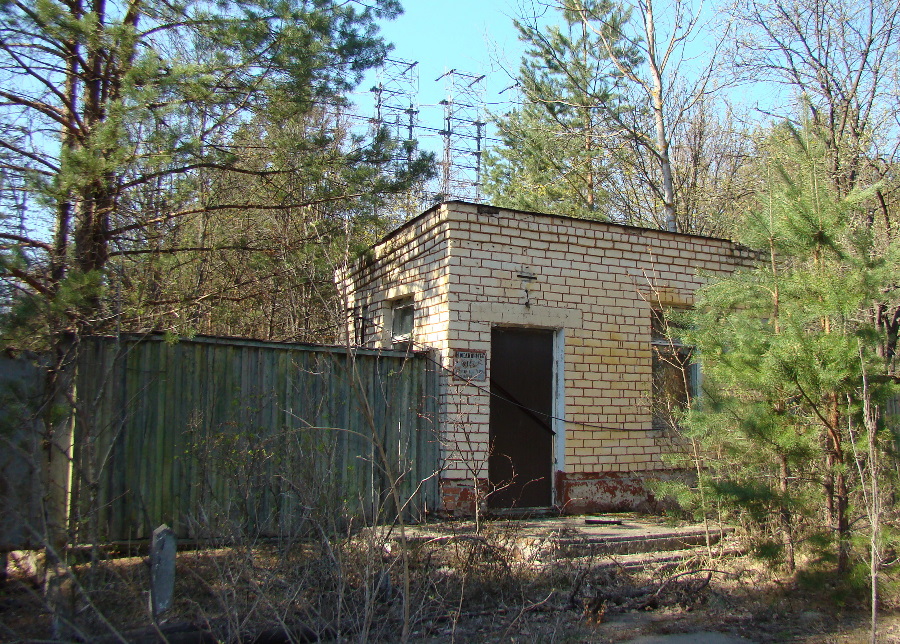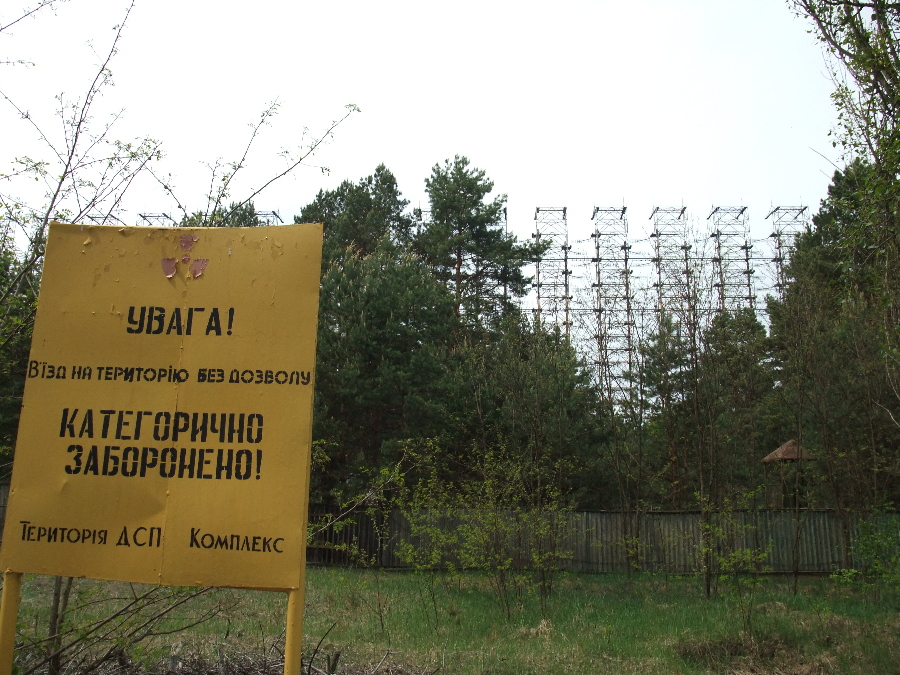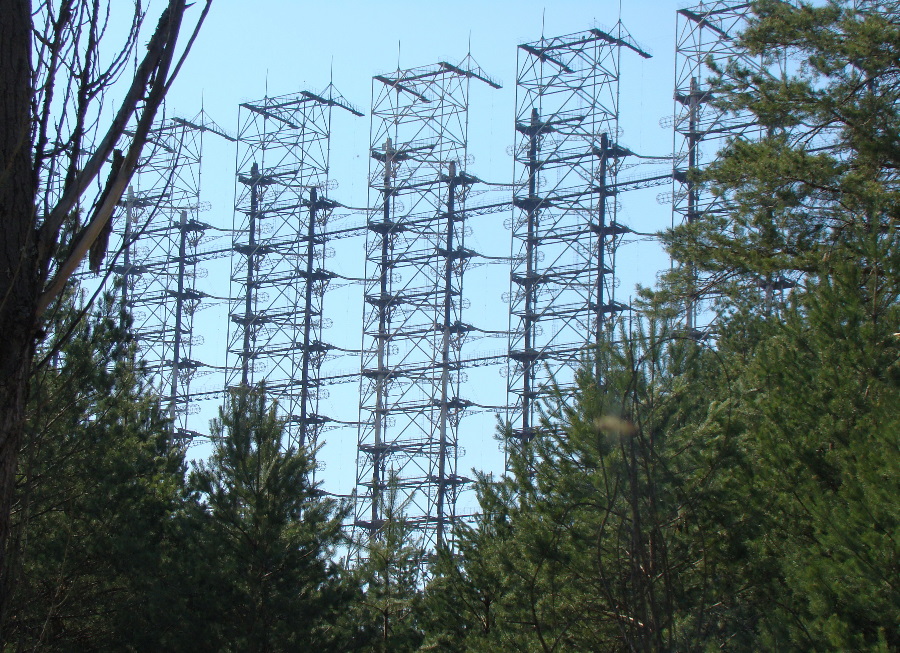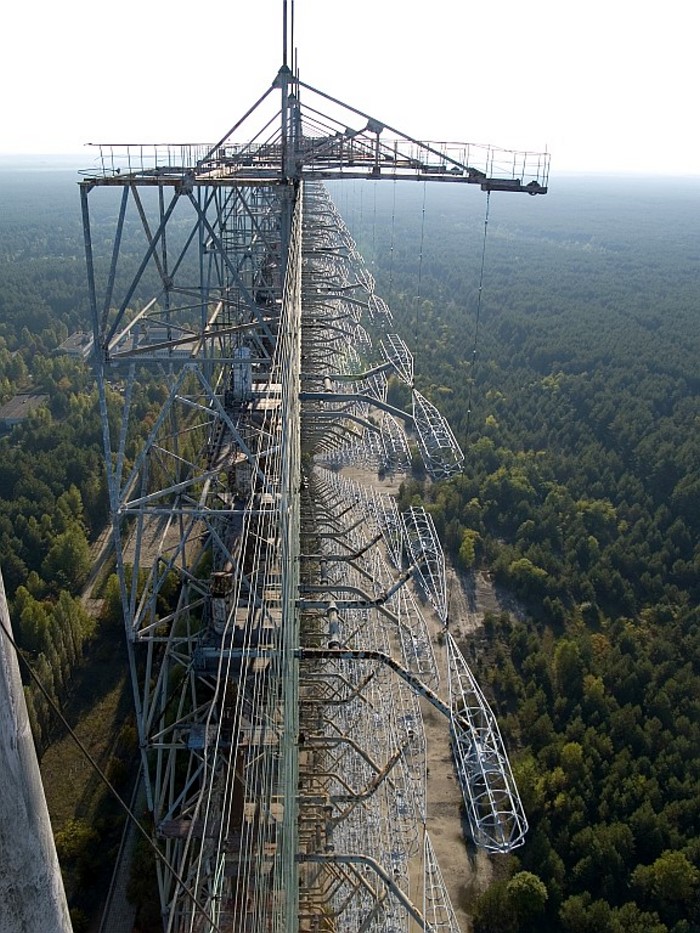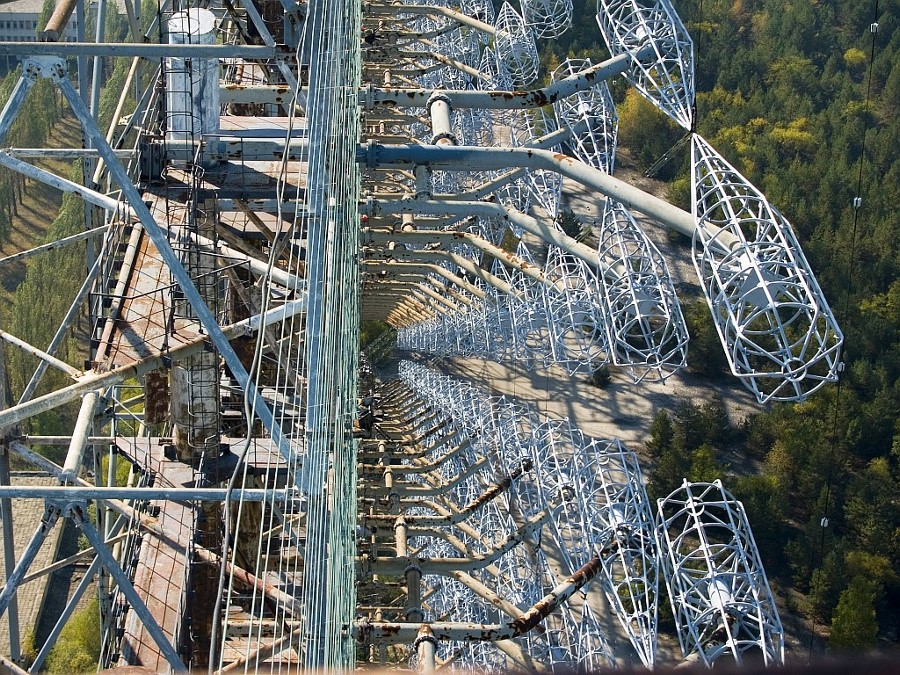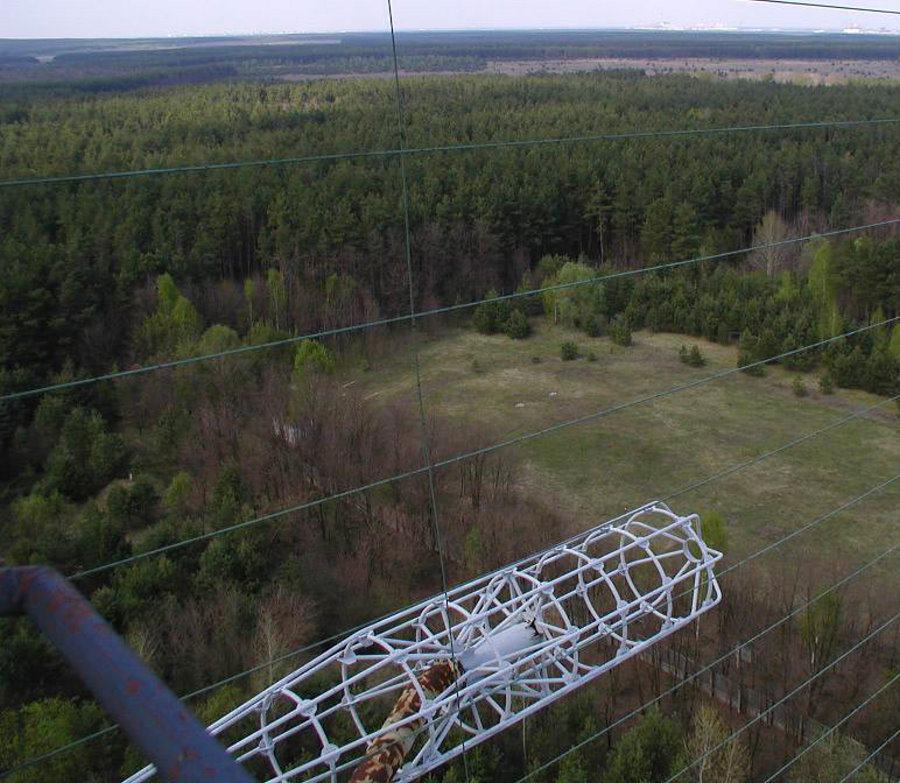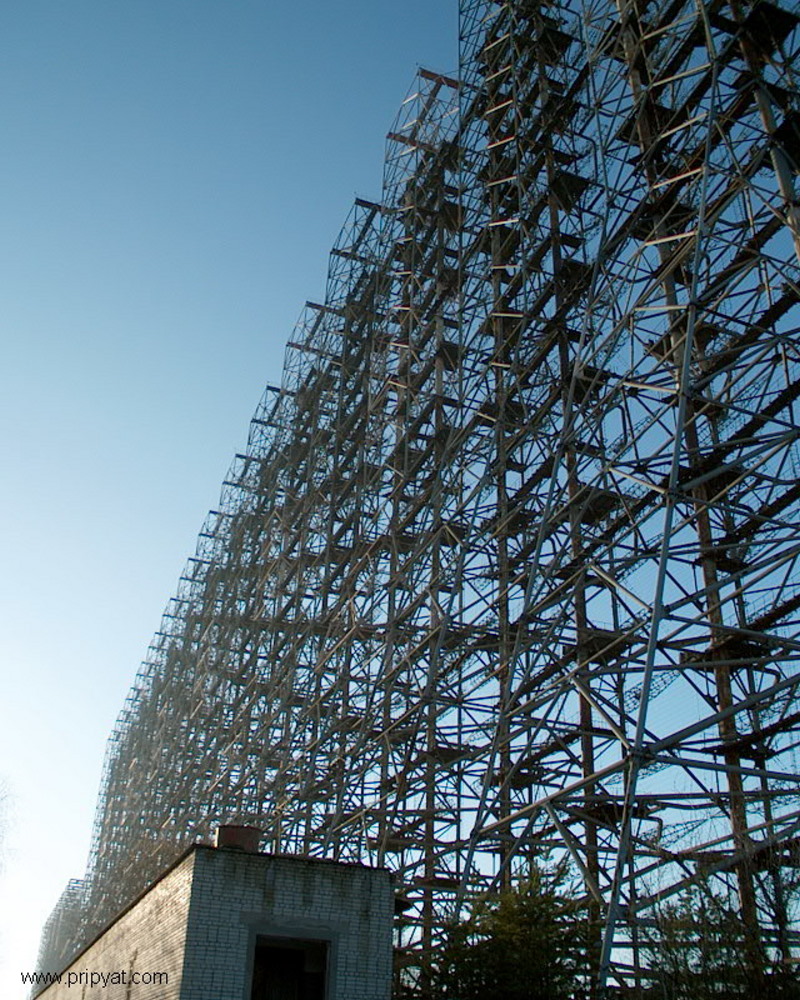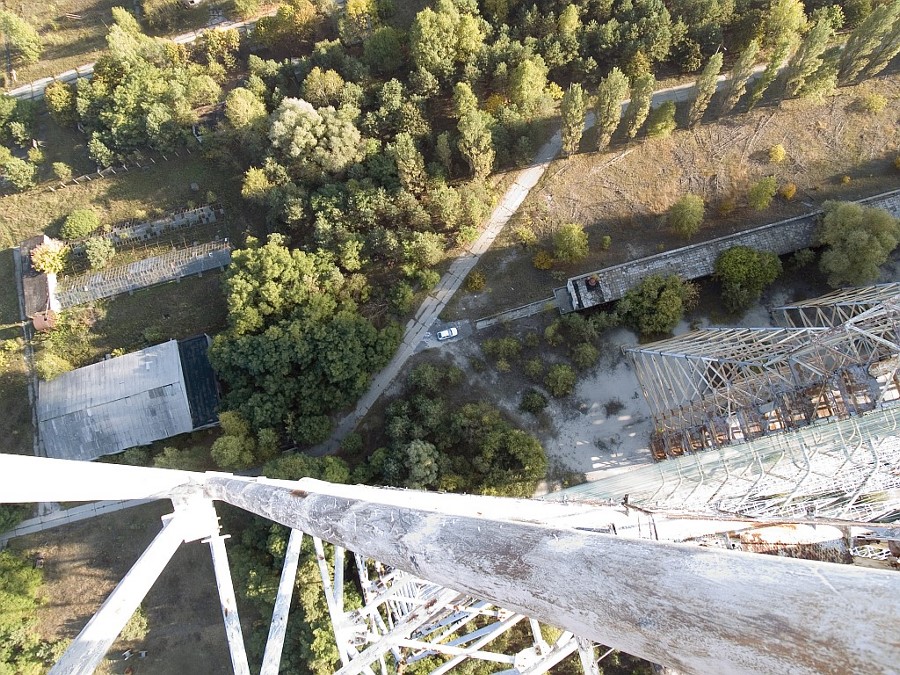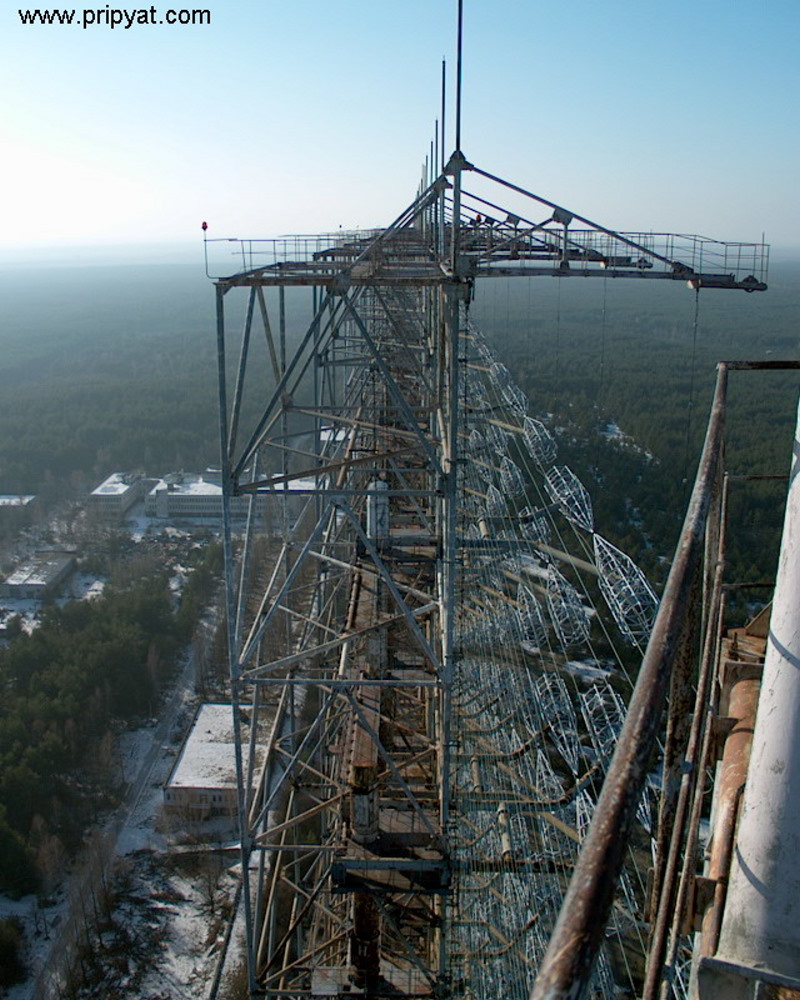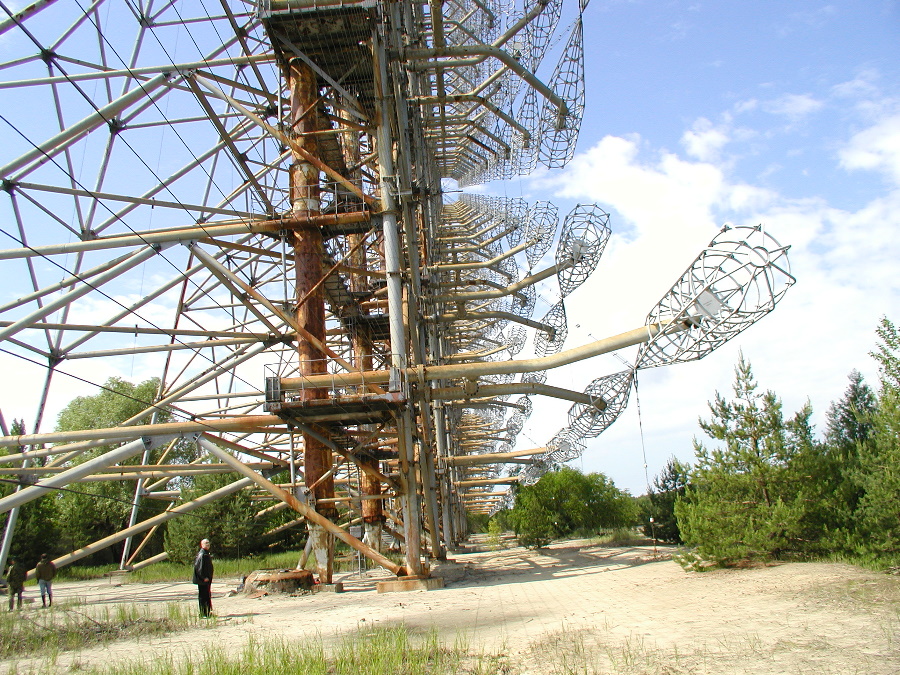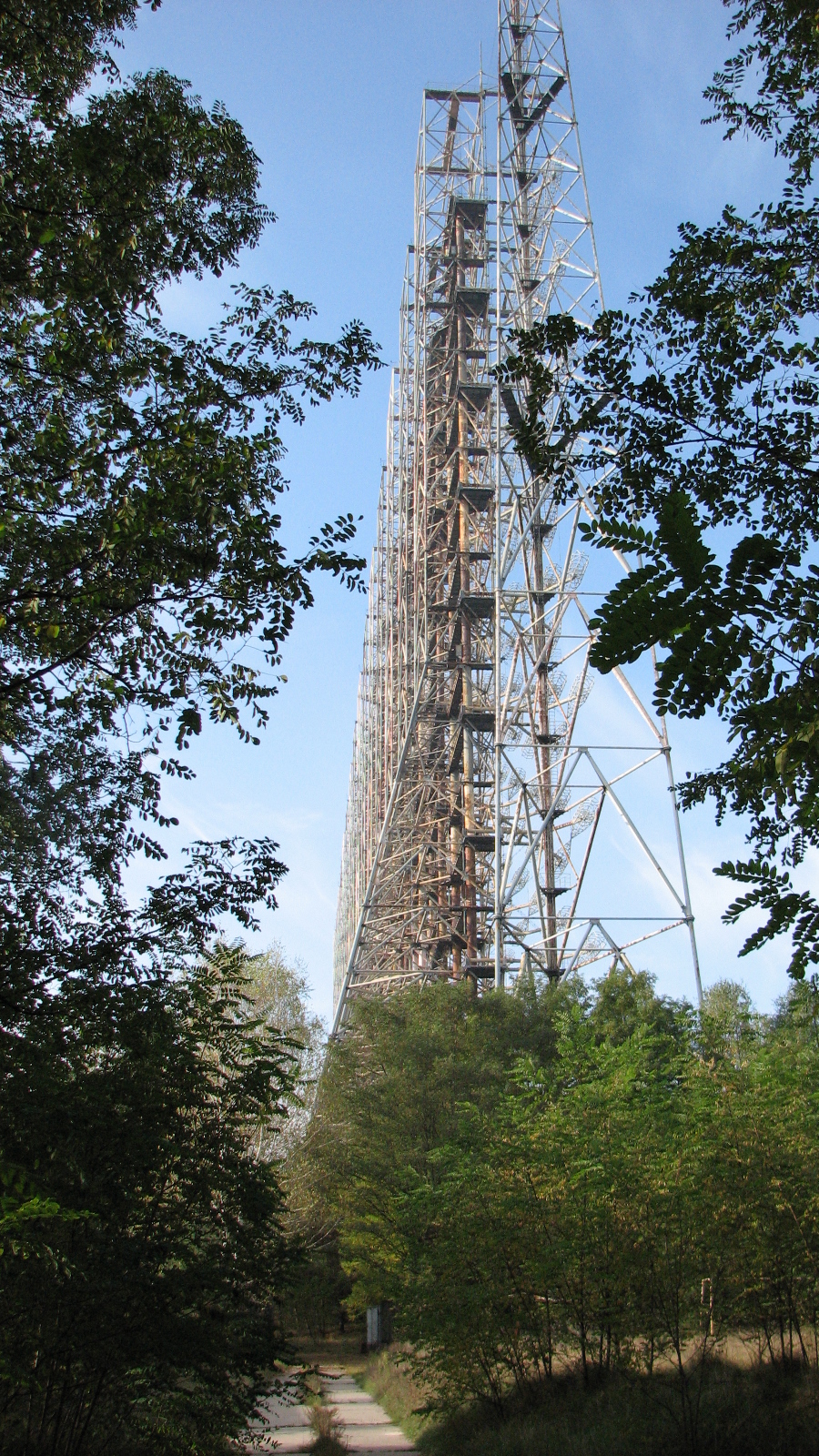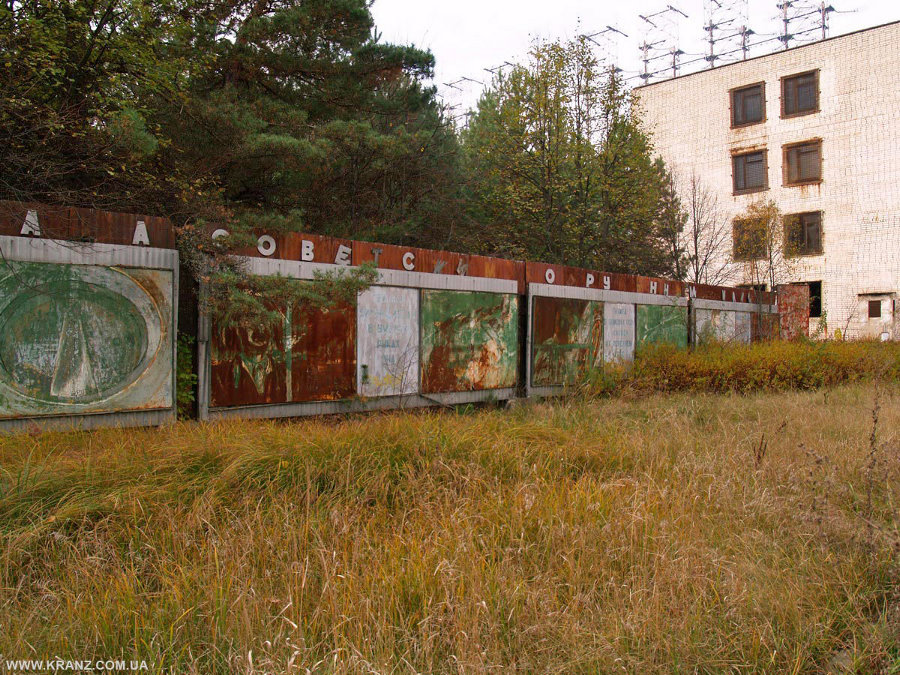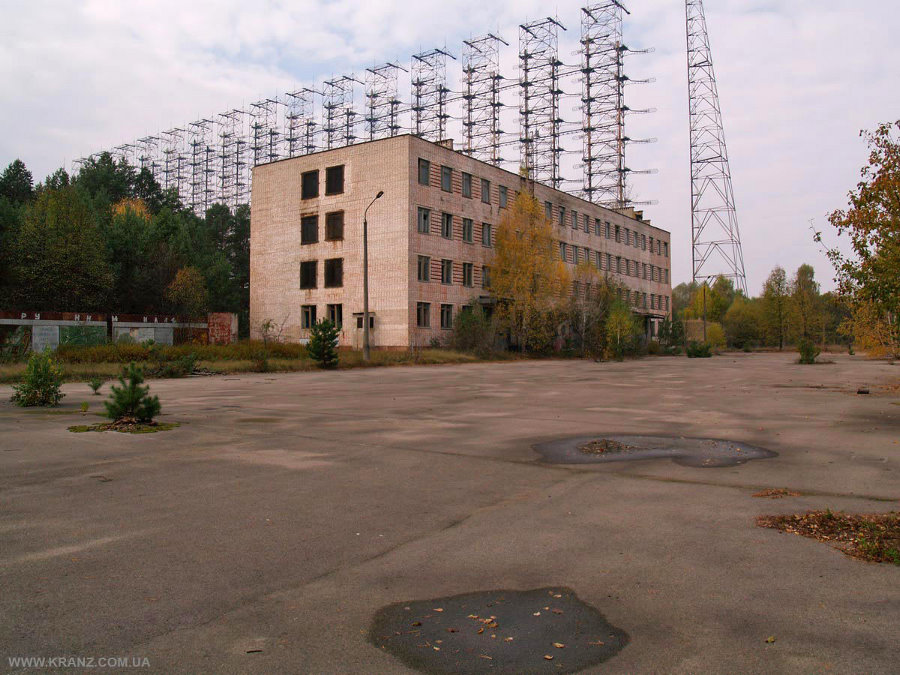|
|
||||||||||
|
Duga Radar Array, Chenobyl, Ukraine 51°18'20.17"N, 30°04'02.60"E ...
The Russian Woodpecker The signal was long believed to be that of an over-the-horizon radar (OTH) system. This theory was publicly confirmed after the fall of the Soviet Union, and is now known to be the Duga-3[1] system, part of the Soviet ABM early-warning network. This was something that NATO military intelligence was well aware of all along, having photographed it and giving it the NATO reporting name Steel Yard.
 Woodpecker
- Woodpecker on shortwave radio interfering with WWVH,
November 2, 1984. Woodpecker
- Woodpecker on shortwave radio interfering with WWVH,
November 2, 1984.
History The Soviets had been working on early warning radars for their anti-ballistic missile systems through the 1960s, but most of these had been line-of-sight systems that were useful for raid analysis and interception only. None of these systems had the capability to provide early-warning of a launch, which would give the defenses time to study the attack and plan a response. At the time the Soviet early-warning satellite network was not well developed, so work started on over-the-horizon radar systems for this associated role in the late 1960s. The first experimental system, Duga-1, was built outside Mykolaiv in the Ukraine, successfully detecting rocket launches from Baikonur Cosmodrome at 2,500 kilometers. This was followed by the prototype Duga-2, built on the same site, which was able to track launches from the far east and submarines in the Pacific Ocean as the missiles flew towards Novaya Zemlya. Both of these radars were aimed east and were fairly low power, but with the concept proven work began on an operational system. The new Duga-3 systems used a transmitter and receiver separated by about 60 km.[2]
Appearance Starting in 1976 a new and powerful radio signal was detected worldwide, and quickly dubbed the Woodpecker by amateur radio operators. Transmission power on some woodpecker transmitters was estimated to be as high as 10 MW EIRP. As well as disrupting shortwave amateur radio and broadcasting it could sometimes be heard over telephone circuits due to the strength of the signals. This led to a thriving industry of "Woodpecker filters" and noise blankers. One idea amateur radio operators used to combat this interference was to attempt to "jam" the signal by transmitting synchronized unmodulated continuous wave signals, at the same pulse rate as the offending signal.[3] This idea was considered, but abandoned as impractical. Simple CW pulses didn't appear to have any effect. However, playing back recordings of the woodpecker transmissions sometimes caused the woodpecker transmissions to shift frequency leading to speculation that the receiving stations were able to differentiate between the "signature" waveform of the woodpecker transmissions and a simple pulsed carrier.[4]
Identification Triangulation quickly revealed the signals came from Ukraine. Confusion due to small differences in the reports being made from various military sources led to the site being alternatively located near Kiev, Minsk, Chernobyl, Gomel or Chernihiv. All of these reports were describing the same deployment, with the transmitter only a few kilometers southwest of Chernobyl (south of Minsk, northwest of Kiev) and the receiver about 50 km northwest of Chernobyl (just west of Chernihiv, south of Gomel). Unknown to most observers, NATO was well aware of the new radar installation, which they referred to as Steel Yard. Even from the earliest reports it was suspected they were tests of an over-the-horizon radar.[5], and this remained the most popular theory during the cold war. Several other theories were floated as well, including everything from jamming western broadcasts to submarine communications. The broadcast jamming theory was debunked early on when a monitoring survey showed that Radio Moscow and other pro-Soviet stations were just as badly affected by woodpecker interference as Western stations. More speculative explanations were also offered, claiming it was a system for weather control or even an attempt at mass subconscious mind control. As more information about the signal became available, its purpose as a radar signal became increasingly obvious. In particular, its signal contained a clearly recognizable structure in each pulse, which was eventually identified as a 31-bit pseudo-random binary sequence, with a bit-width of 100 μs resulting in a 3.1 ms pulse.[6] This sequence is usable for a 100 μs chirped pulse amplification system, giving a resolution of 15 km (10 mi) (the distance light travels in 50 μs). When a second Woodpecker appeared, this one located in eastern Russia but also pointed toward the US and covering blank spots in the first system's pattern, this conclusion became inescapable. In 1988, the Federal Communications Commission conducted a study on the Woodpecker signal. Data analysis showed an inter-pulse period of about 90 ms, a frequency range of 7 to 19 MHz, a bandwidth of 0.02 to 0.8 MHz, and typical transmission time of 7 minutes.
Disappearance Starting in the late 1980s, even as the FCC was publishing studies of the signal, the signals became less frequent, and in 1989 disappeared altogether. Although the reasons for the eventual shutdown of the Duga-3 systems have not been made public, the changing strategic balance with the fall of the cold war in the late 1980s likely had a major part to play. Another factor was the success of the US-KS early-warning satellites, which entered preliminary service in the early 1980s, and by this time had grown into a complete network. The satellite system provides immediate, direct and highly secure warnings, whereas any radar-based system is subject to jamming, and the effectiveness of OTH systems is also subject to atmospheric conditions. According to some reports, the Komsomolsk-na-Amure installation in Siberia was taken off combat alert duty in November 1989, and some of its equipment was subsequently scrapped. Google Maps photography of the area shows that the antenna has been removed. The original Duga-3 site lies within the 30 kilometer Zone of Alienation around the Chernobyl power plant. It appears to have been permanently deactivated, since their continued maintenance did not figure in the negotiations between Russia and Ukraine over the active early warning radars at Mukachevo and Sevastopol. The antenna still stands, however, and has been used by amateurs as a transmission tower (using their own antennas) and has been extensively photographed.
Duga-3, Gomel/Minsk, (Chernobyl-2) 51°18′19.06″N, 30°03′57.35″E and 51°38′15.98″N, 30°42′10.41″E Duga-3, Komsomolsk-na-Amure, 50°53′34.66″N, 136°50′12.38″E and 50°23′07.98″N, 137°19′41.87″E
Appearances in media The Ukrainian-developed computer game S.T.A.L.K.E.R has a plot focused on the Chernobyl Nuclear Power Plant and the nuclear accident there. The game heavily features actual locations in the area, including the Duga-3 array. It is presented as the "Brain Scorcher", a wide-area mind control device which must be deactivated by the player. References:
|
||||||||||
...
...
...
...
...
...
...
...
...
|
||||||||||
| FAIR USE NOTICE: This page contains copyrighted material the use of which has not been specifically authorized by the copyright owner. Pegasus Research Consortium distributes this material without profit to those who have expressed a prior interest in receiving the included information for research and educational purposes. We believe this constitutes a fair use of any such copyrighted material as provided for in 17 U.S.C § 107. If you wish to use copyrighted material from this site for purposes of your own that go beyond fair use, you must obtain permission from the copyright owner. | ||||||||||
|
|
